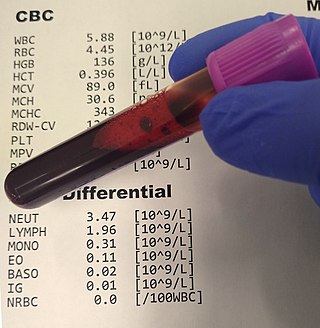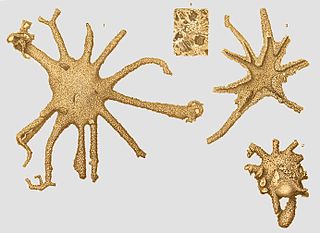
Actinopterygii, members of which are known as ray-finned fish or actinopterygians, is a class of bony fish that comprise over 50% of living vertebrate species. They are so called because of their lightly built fins made of webs of skin supported by radially extended bony spines, as opposed to the bulkier, fleshy lobed fins of the sister class Sarcopterygii. Resembling folding fans, the actinopterygian fins can change shape easily and provide superior thrust-to-weight ratios per movement compared to sarcopterygian and chondrichthyian fins. The fin rays attach directly to the proximal or basal skeletal elements, the radials, which represent the articulation between these fins and the internal skeleton.

Prostate cancer is the uncontrolled growth of cells in the prostate, a gland in the male reproductive system just below the bladder. Early prostate cancer usually causes no symptoms. As the tumor grows, it can damage nearby organs causing erectile dysfunction, blood in the urine or semen, and trouble urinating. Some tumors eventually spread to other areas of the body, particularly the bones and lymph nodes. There, tumors cause severe bone pain, leg weakness or paralysis, and eventually death.

Coronary artery bypass surgery, also known as coronary artery bypass graft is a surgical procedure to treat coronary artery disease (CAD), the buildup of plaques in the arteries of the heart. It can relieve chest pain caused by CAD, slow the progression of CAD, and increase life expectancy. It aims to bypass narrowings in heart arteries by using arteries or veins harvested from other parts of the body, thus restoring adequate blood supply to the previously ischemic heart.

A spirochaete or spirochete is a member of the phylum Spirochaetota, which contains distinctive diderm (double-membrane) gram-negative bacteria, most of which have long, helically coiled cells. Spirochaetes are chemoheterotrophic in nature, with lengths between 3 and 500 μm and diameters around 0.09 to at least 3 μm.

Dementia with Lewy bodies (DLB) is a type of dementia characterized by changes in sleep, behavior, cognition, movement, and regulation of automatic bodily functions. Memory loss is not always an early symptom. The disease worsens over time and is usually diagnosed when cognitive impairment interferes with normal daily functioning. Together with Parkinson's disease dementia, DLB is one of the two Lewy body dementias. It is a common form of dementia, but the prevalence is not known accurately and many diagnoses are missed. The disease was first described by Kenji Kosaka in 1976.

A complete blood count (CBC), also known as a full blood count (FBC), is a set of medical laboratory tests that provide information about the cells in a person's blood. The CBC indicates the counts of white blood cells, red blood cells and platelets, the concentration of hemoglobin, and the hematocrit. The red blood cell indices, which indicate the average size and hemoglobin content of red blood cells, are also reported, and a white blood cell differential, which counts the different types of white blood cells, may be included.

Pseudomonas is a genus of Gram-negative bacteria belonging to the family Pseudomonadaceae in the class Gammaproteobacteria. The 313 members of the genus demonstrate a great deal of metabolic diversity and consequently are able to colonize a wide range of niches. Their ease of culture in vitro and availability of an increasing number of Pseudomonas strain genome sequences has made the genus an excellent focus for scientific research; the best studied species include P. aeruginosa in its role as an opportunistic human pathogen, the plant pathogen P. syringae, the soil bacterium P. putida, and the plant growth-promoting P. fluorescens, P. lini, P. migulae, and P. graminis.

Raúl Rafael Carlos Juliá y Arcelay was a Puerto Rican actor. He was known for his intense and varied roles on stage and screen. He started his career in the Public Theatre before transitioning to film. He received numerous accolades including a Drama Desk Award, a Primetime Emmy Award, a Golden Globe Award, a Screen Actors Guild Award and nominations for four Tony Awards. In 2017, The Daily Telegraph named him one of the best actors never to have received an Academy Award nomination.
The Deferribacteraceae are a family of gram-negative bacteria which make energy by anaerobic respiration.

A myocardial infarction (MI), commonly known as a heart attack, occurs when blood flow decreases or stops in one of the coronary arteries of the heart, causing damage to the heart muscle. The most common symptom is chest pain or discomfort which may travel into the shoulder, arm, back, neck or jaw. Often it occurs in the center or left side of the chest and lasts for more than a few minutes. The discomfort may occasionally feel like heartburn. Other symptoms may include shortness of breath, nausea, feeling faint, a cold sweat or feeling tired. About 30% of people have atypical symptoms. Women more often present without chest pain and instead have neck pain, arm pain or feel tired. Among those over 75 years old, about 5% have had an MI with little or no history of symptoms. An MI may cause heart failure, an irregular heartbeat, cardiogenic shock or cardiac arrest.

Miliolacea is one of five superfamilies belonging to the Miliolida,.

Ales (Alaksiej) Anatoljevich Michalevic is a Belarusian public figure and politician, candidate in the 2010 Belarusian presidential election.
The phylum Elusimicrobiota, previously known as "Termite Group 1", has been shown to be widespread in different ecosystems like marine environment, sewage sludge, contaminated sites and soils, and toxic wastes. The high abundance of Elusimicrobiota representatives is only seen for the lineage of symbionts found in termites and ants.

Cheshire is a county in North West England. In 1974 parts of the historical county of Cheshire were transferred to Greater Manchester and to Merseyside, and parts of the historical county of Lancashire were incorporated into Cheshire, including the towns of Widnes and Warrington. The unitary authorities of Halton and Warrington were created in 1998, and in 2009 the rest of the county was divided into two further unitary authorities: Cheshire East, and Cheshire West and Chester. The ceremonial county of Cheshire consists of those four unitary authorities.
Miliollata is a class wherein Foraminifera is regarded as a phylum that unites the porcelaneous Miliolida, and siliceous Rzehakinidae based on similarities of their tests. Previously the Rzehakinidae were included in the Textulariina based on test wall composition rather than test form. The meaning of Miliolida is retained.

Rotaliata is a class of Foraminifera characterized by tests that are exclusively multichambered, mostly planospiral or trochspiral, or derived from either. The aperture is commonly at the base of the apertural face, at least in early stages, but may be terminal, and single or complex. Test interior may be complex with secondary chambers and interconnecting canal system.

Astrorhizana are a subclass of foraminifera characterized by simple tests composed of agglutinated material that can be irregular, spheroidal, or tubular and straight, branching or enrolled. Tests are non septate and consist of a single chamber following the proloculus. These are the Ammodiscacea of the Textulariina in the Treatise Part C, that range from the Cambrian to Recent.
Lagynana is a subclass of foraminifera which comprises Astrorhizata with membranous or pseudochitinous tests that may have ferruginous encrustations or more rarely small quantities of agglutinated material. The Lagynacea Schultze, 1854, of the Allogriomiina, is fairly equivalent.

Proxima Centauri b, sometimes referred to as Alpha Centauri Cb, is an exoplanet orbiting within the habitable zone of the red dwarf star Proxima Centauri, which is the closest star to the Sun and part of the larger triple star system Alpha Centauri. It is about 4.2 ly (1.3 pc) from Earth in the constellation Centaurus, making it, along with the currently-disputed Proxima c, and Proxima d the closest known exoplanets to the Solar System.

Coronavirus disease 2019 (COVID-19) is a contagious disease caused by the virus SARS-CoV-2. The first known case was identified in Wuhan, China, in December 2019. The disease quickly spread worldwide, resulting in the COVID-19 pandemic.
















